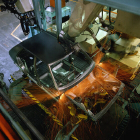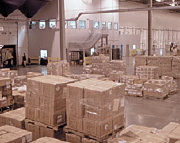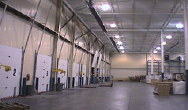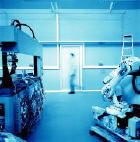Feb. 10, 2003 – Large manufacturers were among the first businesses to discover the benefits of radio frequency identification. Mercedes-Benz embeds RFID tags in chassis going down the assembly line, so both men and machines can identify the type of vehicle they are working on and perform the correct operation. Dell uses RFID to track components, so they can be sent to the assembly line when they are needed. Even big consumer packaged goods companies like Procter & Gamble have been using RFID to identify and track raw materials stored in reusable plastic containers.
So it might seem that the manufacturing sector has the least to learn about implementing low-cost RFID successfully. Nothing could be further from the truth. The systems used today are closed loop — that is, the manufacturer uses RFID to track items internally, and the benefits remain within the four walls of the business. The shift to using open systems, where data is shared with suppliers and customers, heralds changes as profound as any that retailers and distributors will undergo.
In this section of our ongoing Special Report, Low-Cost RFID: The Way Forward, we examine how radio frequency identification is likely to change the way manufacturers run their operations in the short-, medium- and long-term. The aim is to show how manufacturers can take advantage of the opportunities and adjust to the demands of real-time information.
One of the big questions surrounding RFID is: Who will bear the cost of tagging items? Many people believe that large retailers like Wal-Mart, Target, Tesco and Metro will eventually insist that manufacturers put RFID tags on the products they ship to retail distribution centers and stores, just as they have done with bar codes and electronic article surveillance (EAS) tags.
That makes RFID an added cost for the manufacturer. But manufacturers like The Gillette Co. and Kodak are hoping that RFID can be used both for tracking and theft prevention. If RFID can be used to replace EAS tags, then manufacturers will get some of the benefits from putting the tags on. Today, most of the benefits of EAS go to the retailer, while manufacturers absorb the cost.
Some people doubt that smart shelves can be used to prevent shoplifting. Trials are currently underway (see Is This the Future of Retailing?). But even if manufacturers have to put both RFID tags and EAS tags on their products, they can still get a return on investment (ROI), even in the short term.
One way RFID can deliver an ROI in the short term is by improving the verification process. When a manufacture ships pallets to its own distribution center, the goods must be checked in and verified against what’s expected. When the pallets are broken down and reassembled for shipment to a retail store or retail distribution center, the goods must be checked again. This is a time- and labor-intensive process.
IBM Business Consulting Services estimates that RFID can reduce labor costs associated with receiving and checking goods into the distribution by 60 to 93 percent. IBM’s research also found that RFID could slash labor costs associated with verifying the accuracy of an order before shipping it to a retailer by 90 percent. And RFID could also reduce the cost of labor needed to pick the right cases for shipping by 36 percent.
Compliance with specific information and labeling requirements by big retailers has also become a major headache for manufacturers. Manhattan Associates said this week that it would guarantee that users of its software would be compliant with emerging RFID standards used by the world’s top 100 retailers. If manufacturers can place an RFID tag on a pallet and know that software systems will recognize that pallet is bound for Wal-Mart or Kmart and provide the necessary information, then they will save on labor and reduce fees for failing to meet compliance requirements.
At this point, it’s unclear how quickly RFID will be adopted throughout the supply chain. But some manufacturers, such as computer and consumer electronics companies, could require suppliers — or share the costs as a way to encourage suppliers — to put RFID tags on components. The same benefits of automating the receiving of goods at the distribution center could also be applied to the receiving of components at the assembly plant. That would reduce administrative errors and fraud by suppliers who charge for goods they never shipped.
“Shrink” is most often associated with retailers because shoplifting is the most visible form of shrinkage. But manufacturers suffer losses from shrink as well. These usually deal with process failure, rather than theft, says IBM Business Consulting Services. The manufacturer ships more product than it should to a retailer, fails to accurate account for returns, or pays for more material than suppliers delivered. IBM estimates that manufacturers could save more than $1 billion per year in this kind of loss by using RFID.
Can all of these benefits really be achieved? Maybe. Anyone who has ever implemented a complex information technology system knows that the cost are usually greater than expected and the benefits smaller. But even if companies only get half the benefits IBM Business Consulting Services suggests, an RFID system that automates verification and compliance will still pay for itself within two years.
The medium- and longer-term benefits will be much harder to achieve because they involve more fundamental changes to business processes and require cooperation throughout the supply chain. The major mid-term benefit is to reduce out-of-stocks at retail, thereby increasing the manufacturer’s sales, while simultaneously reducing inventory on hand.
Out of stocks hurt manufacturers as well as retailers. Accenture did a study for the Coca-Cola Retailing Research Council and found that CPG manufacturers lose up to 3 percent of sales due to out-of-stocks. That means the manufacturers are missing out on a chance to increase sales by $12 billion annually.
Another big problem for manufacturers is having products that can’t be sold because they are either too old, in the wrong place or there is no demand. A recent study by the Grocery Manufacturers of America found that manufacturers’ unsaleable goods reach 1.27 percent of total sales last year. That translates into more than $5 billion in excess costs for manufacturers.
The aim of using RFID is to provide better information about consumer demand and about what goods are in the supply chain and where. If retailers share real-time, or near real-time, data about what’s happening in the store and what’s available in the back room of the store, manufacturers can better match supply to demand.
“Today, for the most part, we know the product demand and the product in the pipeline up to what we ship to the customer,” says Simon Ellis, supply chain futurist for Unilever. “If we can know those things all the way to the backroom of the store, then we are two or three days away from the point of relevance, which is the consumer purchase point. So we are forecasting a few days, rather than weeks, or months or quarters. That could potentially revolutionize the way that we manage our supply chain.”
Getting that data from the retailer is by no means a given. But even without it, RFID can provide a huge improvement in the quality of data that manufacturers can use to forecast sales. In its business case for the Auto-ID Center, “Auto-ID on Demand: The Value of Auto-ID Technology in Consumer Packaged Goods Demand Planning,” Accenture describes the benefits of RFID for a fictional manufacturer called Beauty4U, which sells $4 billion worth of cosmetics annually.
Beauty4U has installed RFID readers at dock doors in three modern manufacturing facilities and at its ten distribution facilities. The company tags pallets and some cases and captures accurate information on inbound goods from manufacturing and outbound shipments to its customers’ (retailers’) distribution centers.
The demand-planning manager gets sales forecasts from her direct sales force and combines this information with accurate, up-to-date historical sales volume data for each customer and seasonal fluctuations. With this data, the manager can forecast demand more accurately, which means Beauty4U can reduce safety stocks by 5 percent and free up $15 million in working capital.
The company could also cut lead times by a week because it can use the data from RFID tags to better synchronize deliveries with retailers. That would help reduce out of stocks to less than 5 percent, which translates into a 1-percent increase in sales, or $40 million in additional revenue. Unsaleables could also be reduced by 5 percent, saving another $2.2 million.
Accenture puts the cost of the RFID system at $5.3 million including $4.25 million for system integration. The manufacturer would incur about $1 million per year in recurring costs, such as buying tags and maintaining the system. But the benefits clearly outweigh the costs.
Accenture says that RFID could deliver on the benefits promised by collaborative planning forecasting and replenishment (CPFR) by making forecasts more accurate and supply chains more efficient. CPFR studies and pilots indicate that a 10 to 30 percent improvement in forecasting accuracy would help manufacturers lower inventory levels by 5 to 30 percent, cut warehouse and transportation costs by 2 to 13 percent and improve sales by 1 to 5 percent by reducing out of stocks.
There is a downside to having better information, as well. Retailers have been getting more sophisticated about analyzing vendors in terms of how they contribute to the retailer’s profits. RFID will give them much better data about which retailers are not delivering on time, which have the most errors in shipping orders, which have the most out of stocks and which impose the greatest administrative burden them. The retailers will likely focus their joint marketing efforts on those manufacturers that are hyper-efficient and reduce the retailers’ own expenses. They could even drop suppliers that do not contribute to their bottom line.
In the long-term, however, RFID may help manufacturers move to mass customization and even direct sales. The Auto-ID Center lab in Cambridge, England, has set up a demonstration with a robot that picks Gillette products from a shelf and assembles gift packs based on a customer’s interest. If you want two packages of razors and no shaving cream, the robot will pick the items by reading the RIFD tags on them and assemble a custom order.
It’s a very simple demonstration, and factories have done this kind of thing with other technologies for a long time. But RFID has the potential to usher in a new era of robotics. The problem with robots has always been that they are not as flexible as humans are. They can perform the same routine task over and over again without complaining, but they are limited in their ability to “see” objects and to react when things go awry.
RFID enables robots not just to identify objects, but to interact with them. Components themselves could carry recipes — instructions for how they should be assembled. These instructions would be rule based and would tell robots what to do when different situations arise. Let’s take a very simple example.
Robots are installing hard drives in computers coming down an assembly line. The RFID tag on the next PC says it should get a 40 GB hard drive. The robot turns to the bin and sees it is empty. Instead of production stopping, the robot reads the tag and looks up the PC’s identifying number in a network database. The robot informs the software used to optimize production that it is out of 40 GM hard drives. The software looks at orders in the pipe and tells the robot to install an 80 GB hard drive. The robot turns to the appropriate bin, picks up the right hard drive and installs it. The software then adjusts the production schedule to produce more PCs with 80 GB drives now and more with 40 GB hard drives when the stock can be replenished.
This could open up the world of mass customization the futurists have been predicting for years. Mrs. Smith picks out a new car at the local dealership, then sits down at a computer with a sales rep. They click on each feature that she wants, body color, seat style and so on. When she’s done, the rep clicks OK, and the order is sent to the factory. The RFID tag on a chassis is associated with Mrs. Smith’s order, and robots look up in the database what options have been chosen and assemble a custom car in a matter of days.
Of course, RFID is not a magic bullet for manufacturers. It’s simply a way of capturing accurate, real-time information. To get all of the potential benefits, manufacturers will need to enhance their IT systems to enable them to react to the real-time data, whether it’s a sudden spike in demand or a glitch on the assembly line. They will also need to change their business processes and train people to use the data that will be at their disposal. It’s a difficult task, but it’s one manufacturers will have to undertake to remain competitive.





